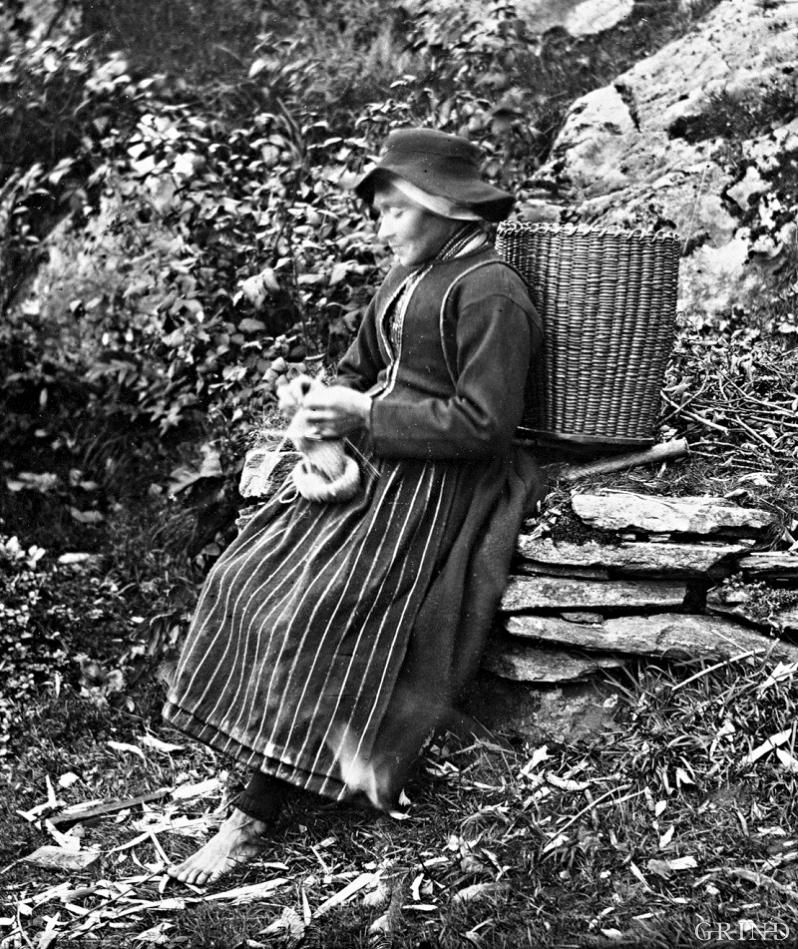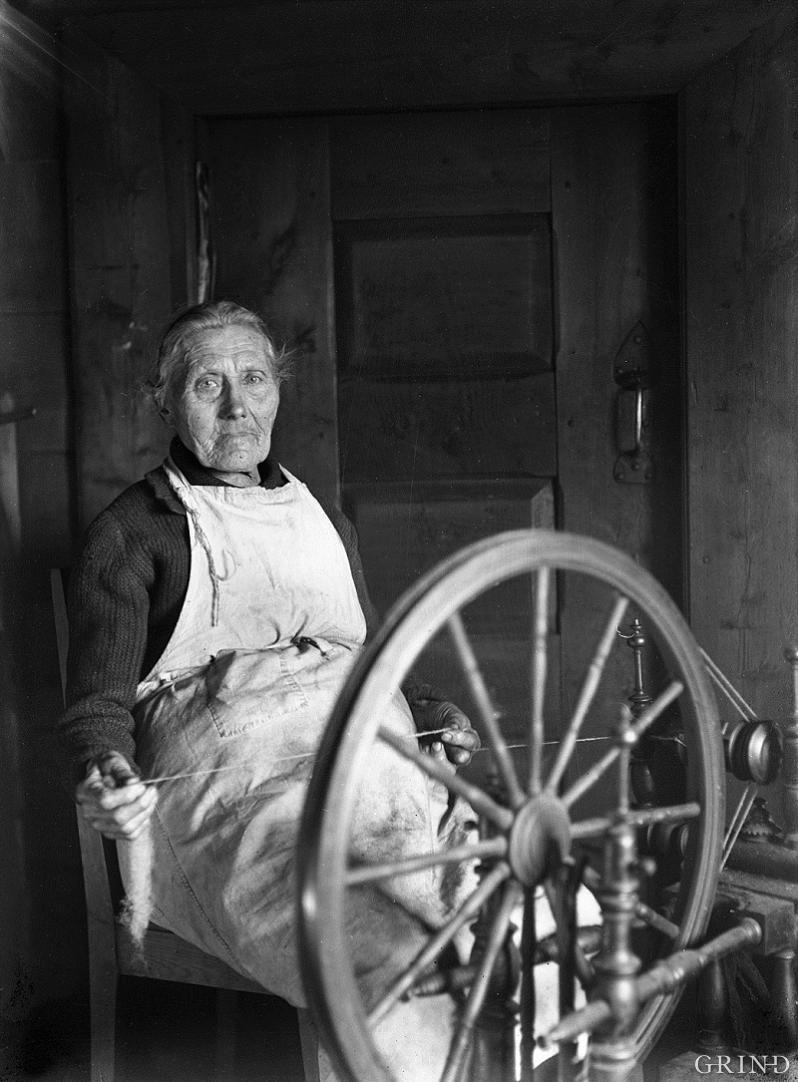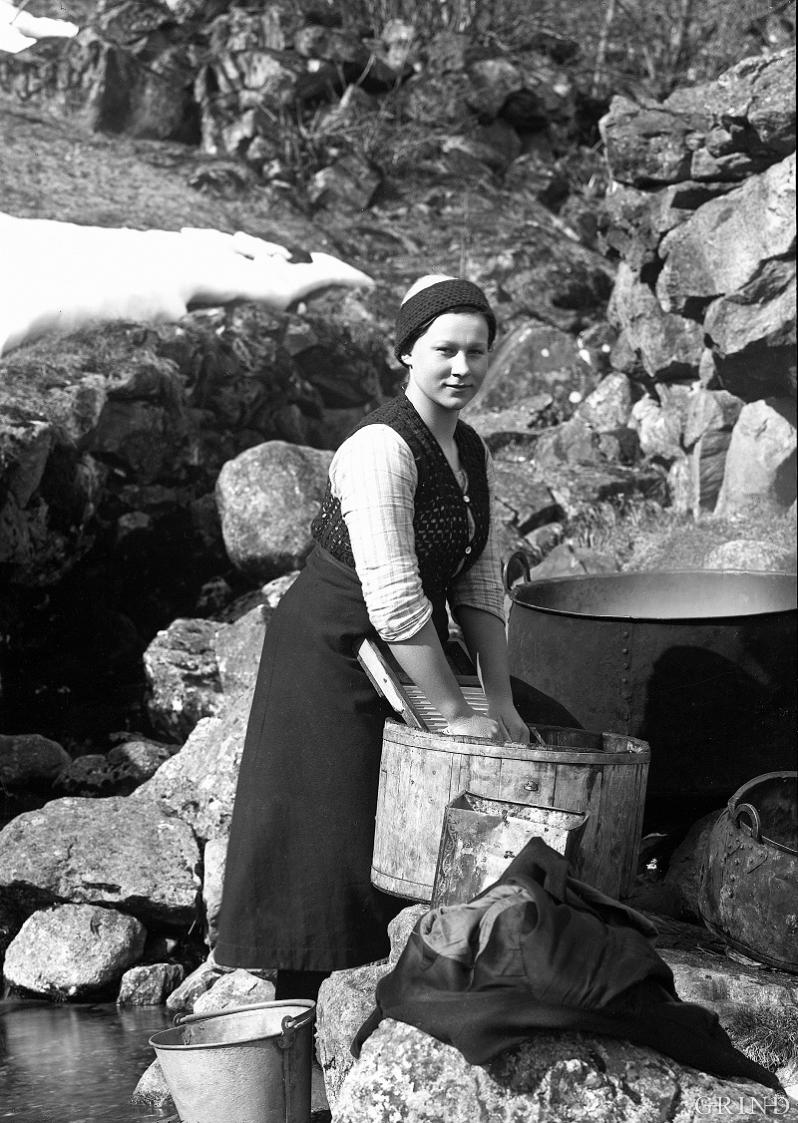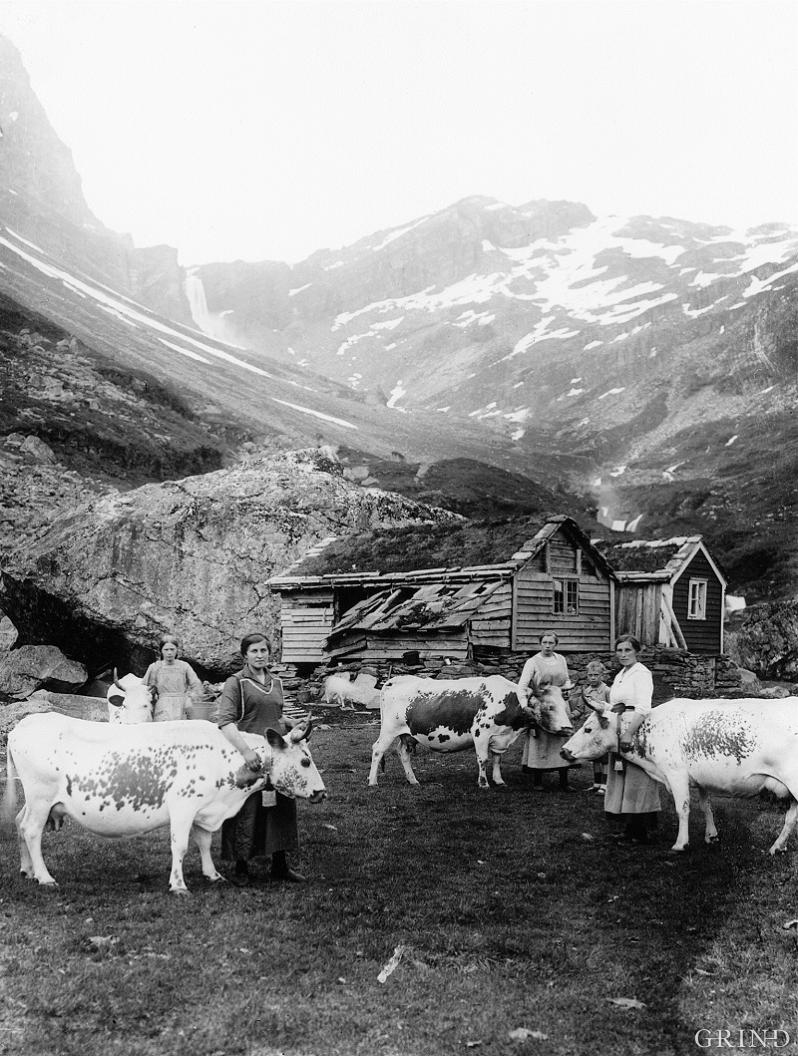Published: 19.05.2009 | Author: Eldbjørg Fossgard, Ågot Gammersvik
The farm women had to use much of their time on washing clothes. Usually one whole day a week, or a couple of days every other week they leant over the washing basins and washing boards. On the islands out on the coast they often had a fixed washing place at the lake on the island. In the fjord country the washing place was by a stream or a river. If several women did their main wash on the same day, it could be a pleasant if wearing period of work. (Knud Knudsen, owner: Picture collection, University Library in Bergen (KK 3433 (13x18))). (section)
“Lack of cleanliness is one of the ugliest habits of the coastal population. It gets into everything ... into the living room where the whole family spends day and night, where meals are eaten, where there is often cooking, where wet clothes are dried, there you come upon filth which, in many areas is quite amazing. Sweeping is done sparingly and several weeks and even months can go by, without washing.”…
This characterisation of domestic life in the outer districts of Hordaland are to be found in a little public information pamphlet from 1854, written by the doctor D.C.Danielsen of St.Jørgen’s Leprosy Hospital in Bergen. We come across the same attitudes in the reports from the new district doctors of the same period; zealous spokesmen as they were for a hygienic standard in the battle for public health. However it would be most unfair if this were to remain a hallmark of the efforts of women in the farming households. And different considerations were expressed in the debate on society during the 19th century.
The picture seems to be consistent with that found by Eilert Sundt on his travels in “Søndhordland’s and Midthordland’s Presbyteries” whilst the conditions in “Cleaning Practices” was better in the inner rural districts in Hardanger and Voss as he portrays in his book on “Domestic Life in Norway” (1873). He defended the lack of cleaning work by women by saying they had far too much to do, and that cleanliness was equally dependent on the man:
“ …. The farmer who wants his wife to take more responsibility for looking after the house and the children’s care and upbringing, should, for example, give her a servant girl to help in the dairy, or at least he should consider introducing some help for the housework, like bringing piped water so that his wife no longer needs to bring water from the river to the dairy and the kitchen”
The reality was that the women had fearfully strenuous working conditions in the old farmhouse life; perhaps they were even more important for the home and living conditions than the man. In many districts of Hordaland the men were away for large parts of the year; fishing, cargo transport or in construction. The women had the responsibility for getting ends to meet on a daily basis, and in many places hers was the main responsibility for running the farm.
Ways and forms of living
The common feature of the outer coastal districts and the inner fjord districts of Hordaland today is that we find well-maintained farms where the main farmhouses are villas and the working buildings are modern and up-to-date. Many of the old farm buildings have been pulled down. The cultural landscape is influenced by the new times.
The social landscape is also new. If you take a morning stroll in one of these farming hamlets there is a good chance that you will not find anyone there. Probably you will not find the farmer’s wife either in the fields or in the dairy. It is most probable that she will be at work - outside the farm. If she is at home it is because she has small children to look after. She still has the responsibility for the welfare of the rest of the family.
The picture which confronts us today is in great contrast to the picture of the women in the society which existed in this part of the country a hundred years ago. But whilst the household of today is in most cases identical with a core family with parents and children, then the household consisted of the family with two or three generations, as well as unmarried relatives and servants.
The purpose of the work was to produce food and other items for their own consumption and to produce items for sale. Of course the most important thing was to meet daily needs, but it was also essential to have a surplus from their own production to be able to buy or exchange other goods. Agriculture was very often combined with a series of other businesses, such as fishing, shipping, handicrafts and later factory work. Because it was always the men who were involved it fisheries, the great bulk of the agricultural work fell to the women.
The women farmers
In the coastal districts it was very common that the man’s main occupation was a fisherman or a seaman, or he was engaged in transport of goods, and it was his wife who worked at home on the farm. For the household, it was fisheries which was the most essential economic factor, but they could not live without agriculture. In several districts at the beginning of the 20th century many of the men travelled to America, whilst the women and children shared the toil at home. This is how life was portrayed for a women from Tysnes who was born in 1907: “Father was in America for all the time that I can recall. He come home now and then, and then he went off again. He was a sailor. So Mother worked hard on the land at home, and it was a small place. It was we and our mother who did the work there. We were three boys and a girl, and I was the only girl. We had two-three cattle, usually two, but no horse. It was Mother who did most of the work, she cut the hay and carried it in. But we had to help Mother and we carried many sheaves of hay. And then we had to go by boat when we were shopping, when we went to the distant fields to go milking, and even when we had to go to look for firewood”
But the man of the house did not have to be away from the family for the whole of the year. In Bergen there were many men who got jobs in the factories or as carpenters after the turn of the century. While in earlier times they had been more or less established at home, the new work meant that they would come home on Saturday and go of again on Sundays. A so it was the wife and the rest of the household who had to take on the daily toil of the farm. On Osterøy entire villages were emptied of men during the week.
But the women were not only the coastal farmers; to a large extent they were also the farmers of the interior on the farms where the men were away on other work for the whole year or for periods of the year. Measured in terms of total working hours put in, the women were more important than the men home on the farm. But we have to bear in mind that the household as an economic unit would hardly be able to manage without the monetary incomes which the men had outside the farm. On the larger farms the men and women worked side by side with working tasks clearly divided on a basis of gender, but it is also important to stress the feeling of community: “We girls were out doing the farming work, we were on equal terms with the boys” tells an older woman from Arna. The practical working contribution of the women was not less after the major processes of change which agriculture experienced from the 1870s up until the Second World War.
A gradual easing of the burden
What the story from Tysnes also illustrates was that the way they worked and the tools and equipment they had on the small, steep farms had hardly undergone any change since the 1870s. Just us in the generations before, the women carried on taking manure out in baskets on their backs, with loads of more than 50 kilograms. They also used the baskets to carry potatoes from the fields and peat for fuel, and they were the only tool they had for carrying home heather and seaweed when additional supplies had to be secured.
In a fjord district like Arna developments in techniques and ways of doing things went more quickly than out on the coast, and the newly purchased machines eventually had great consequences for women’s work. Especially in the years after 1910 there were many folk who bought harvesting machines, harrows and ploughs and both men and women were liberated from the toil of working on the land and of carrying. Carrying manure in a basket disappeared and so too there was an end to spreading manure from a cart or a sledge with only hand power. And as men took most of the work with horses and horse equipment, the women retired more from certain aspects of the farming work. But on the other hand the establishment of dairying from the late 1880s led to milk production becoming more important than ever. In this area women experienced many changes in the work. On small farms the production was increased in relation to what it was before, and the women took on pigs, hens and vegetables.
Woman and cattle belong together
Looking after cattle was looked upon as a true women’s work. The men had never learned to milk, and it was against all the norms that a man should go into the dairy. If the wife needed relief with the milking it was a woman pensioner or a servant girl who took her place. “It is a real exception if the farmer himself can milk” tells the first peripatetic teacher in dairying from Haus as late as 1901 and he thought it was important that men came into the work. The main argument was that with increased sales, milk production was so important that it could no longer be left to women alone. It took time, because the old standards still applied in the 1930s in many districts, such as we hear from a woman in Stord: “It was like this here that a man could not show himself in the cowshed, because if he did he was not an adult. So we still had to do everything alone”.
It was first when milking machines came into use in the 1940s and the 1950s that the men worked in the dairy as naturally as the women did. Now dairying work had become much lighter and there was an end to the heavy carrying of water that the women had struggled with for generations.
“…The comfort of their environment and the attraction of domestic life”
Everything that related to domestic life was understood to be women’s responsibility and women’s sphere. When the lack of cleanliness was so great in western Norway in the 1850s it was because women were “not up to their role” as we encounter in the introduction to this article.
The daily food was simple and the setting of the table was not given much attention. Porage, potatoes, herring and thin crispbread were fixtures in the diet. The most important task was to secure the daily food supply for large and small and to ensure that the corn store was never empty. Between the Wars new foodstuffs came into use, both in the coastal districts and inland. Coarse wheat came in addition to barley and rye, and carrots, swede, cabbage and onion entered the diet. Many of these were purchased items which reduced the work involved in domestic production.
The production of textiles for cloth and equipment for the whole household also belonged to women’s work. This was undertaken first and foremost during the winter, but was more flexible than other work. For example, a man from Ullensvang tells us from the 1890s:
“At home in the living room, the sound of the spinning wheel was to be heard from morning until late at night. There was carding and spinning month after month, right up until the days became longer. Later the warp beam was introduced and when this happened there was weaving for a long time. Mother wove first and foremost homespun cloth for outer garments, but also for underwear and bedclothes …. But Mother also tried her hand with decorative weaving. She made patterned dolls’ clothes in many colours. The yarn for these had to be especially fine, and she dyed it herself with plant colours”
During the period 1915-1935 the degree of home-made textile work fell greatly. Purchased goods replaced home-woven materials in many households, and purchased dyed yarn was much more common than home-made yarn. Those who were young wives in the 1930s can tell us that they always bought materials and had never learned to spin.
All child care was linked to the role of women. The children were where the mother was, whether she was cooking food or out weeding in the fields. This was the first training for work. When she handed the children over to other folk, it was to servant-girls or to grandmothers. The housewife also had to take care of the old folk in the household, when they were sick and could no longer look after themselves. Some of them were dependent on feeding and being cared for. The old folk were part of the daily life.
Administrators, but economically subordinate
There is no doubt that the housewife or the wife on the farm occupied a central position in the old farming society. She was indispensable in the keeping of the house. She made sure that the animals were looked after and were healthy, and it was she who was the one who did the caring work in the household. At the same time she was the one who organised the food. She was the main one responsible for the renewal of the family’s manpower, through the birth of children. A farm without a housewife simply could not be run, if it was going to survive.
But if the housewife was central to the work of the household in times gone by, this did not mean to say that it gave her the highest status. We must bear in mind that although the role of the housewife was a central one both economically and administratively, it was the farmer himself who was the main person on the farm, both in his own eyes and in those of others. As the sale of farm products increased during the 20th century, it was always the man who took charge of the economy. The man also had the undisputed authority to administer the farm as his own property.
The farm wives become helpers
In the period after the Second World War the organisation of the work of the farming household has changed very much on the west Norwegian farm. The two most important reasons for this are the change in operations and the powerful technological development in agriculture after the Second World War. Many of the working operations which were previously allocated to women have either been changed radically or have completely disappeared with the introduction of new technology. The washing machine the freezer and other kitchen machines have upturned much of the working day for women indoors. The tank system in the dairy and the fetching of milk in tanks which took off seriously in the 1970s meant that in many places, the man took over the work in the dairy completely. Similarly the need for manpower in outdoor work has been greatly reduced. And this has given rise to greater individual freedom than previously with regard to how the family organises its work.
In the rural districts of Hordaland we have seen a clear tendency for women to withdraw from outdoor work and work in the dairy, and these working areas have become dominated by men, or “masculinised”. The majority of farmers’ wives have a role today of “helper” for the man both in the dairy and outside, and their manpower is no longer indispensable. The women farmers from the previous centuries have become farmers’ wives.
- Avdem, A. J. & Melby, K. (1985) Oppe først og sist i seng: husarbeid i Norge fra 1850 og til i dag. Oslo, Universitetsforlaget.
- Fløystad, I. (1986) Kvinnekår i endring: kvinnene sitt arbeid i Arna, Hordaland 1870-1930. Bergen, Universitetsforlaget.
- Sundt, E. (1976) Om huslivet i Norge. Verker i utvalg, nr. 10. Oslo, Gyldendal.
- Thorsen, L. E. (1993) Det fleksible kjønn: mentalitetsendringer i tre generasjoner bondekvinner 1920-1985. Oslo, Universitetsforlaget.









